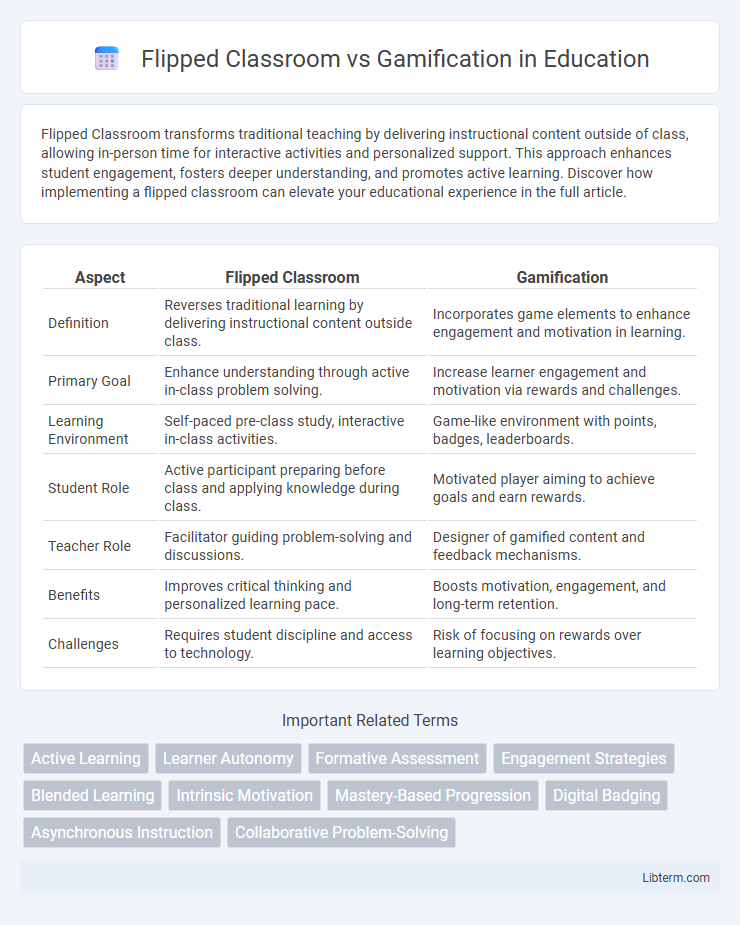Flipped Classroom transforms traditional teaching by delivering instructional content outside of class, allowing in-person time for interactive activities and personalized support. This approach enhances student engagement, fosters deeper understanding, and promotes active learning. Discover how implementing a flipped classroom can elevate your educational experience in the full article.
Table of Comparison
| Aspect | Flipped Classroom | Gamification |
|---|---|---|
| Definition | Reverses traditional learning by delivering instructional content outside class. | Incorporates game elements to enhance engagement and motivation in learning. |
| Primary Goal | Enhance understanding through active in-class problem solving. | Increase learner engagement and motivation via rewards and challenges. |
| Learning Environment | Self-paced pre-class study, interactive in-class activities. | Game-like environment with points, badges, leaderboards. |
| Student Role | Active participant preparing before class and applying knowledge during class. | Motivated player aiming to achieve goals and earn rewards. |
| Teacher Role | Facilitator guiding problem-solving and discussions. | Designer of gamified content and feedback mechanisms. |
| Benefits | Improves critical thinking and personalized learning pace. | Boosts motivation, engagement, and long-term retention. |
| Challenges | Requires student discipline and access to technology. | Risk of focusing on rewards over learning objectives. |
Understanding the Flipped Classroom Model
The Flipped Classroom model reverses traditional teaching by delivering instructional content online outside of class, allowing in-person sessions to focus on interactive activities and personalized support. Students engage with video lectures, readings, or quizzes at their own pace before class, fostering deeper understanding and preparation. This approach enhances active learning and improves retention by shifting from passive consumption to collaborative problem-solving during classroom time.
What is Gamification in Education?
Gamification in education integrates game design elements such as points, badges, and leaderboards into learning environments to boost student engagement and motivation. This approach leverages competition, rewards, and interactive challenges to enhance comprehension and retention of educational content. By transforming traditional lessons into dynamic, game-like experiences, gamification fosters active participation and can improve overall academic performance.
Key Principles of Flipped Classrooms
The flipped classroom model restructures traditional teaching by delivering instructional content, often online, outside of class, allowing in-person sessions to focus on active learning and problem-solving. Key principles include pre-class preparation through video lectures or readings, interactive and collaborative activities during class time, and continuous assessment with immediate feedback. This approach enhances student engagement, fosters self-paced learning, and maximizes the use of face-to-face instruction for higher-order cognitive tasks.
Core Elements of Gamification
Core elements of gamification include points, badges, leaderboards, challenges, and feedback systems that enhance learner engagement and motivation by creating a sense of achievement and competition. Unlike the flipped classroom model, which shifts traditional instruction to pre-class activities, gamification integrates game mechanics into the learning process to promote active participation and reinforce content retention. Incorporating core gamification elements effectively transforms educational experiences by providing immediate rewards and fostering a collaborative and interactive learning environment.
Benefits of Flipped Classrooms for Learners
Flipped classrooms enhance learner engagement by allowing students to access instructional content at their own pace, fostering deeper understanding and retention. This approach promotes active learning during class through collaborative activities and personalized feedback, which improves critical thinking and problem-solving skills. Research indicates that flipped classrooms significantly increase student motivation and academic performance compared to traditional teaching methods.
Advantages of Gamification in Learning
Gamification in learning boosts student engagement by incorporating game elements like points, badges, and leaderboards, which motivate learners through competition and achievement. It enhances knowledge retention and skill development by making educational content interactive and fun, leading to increased participation and improved performance. Unlike the Flipped Classroom model, gamification provides instant feedback and adaptive challenges, catering to diverse learning paces and styles.
Comparing Engagement: Flipped Classroom vs Gamification
Flipped Classroom promotes active learning by having students review content at home and engage in interactive activities during class, increasing participation and deeper understanding. Gamification leverages game design elements such as points, badges, and leaderboards to motivate learners through competition and rewards, resulting in higher enthusiasm and sustained engagement. Comparing engagement, gamification often yields more immediate motivation through fun and challenge, while flipped classrooms foster long-term cognitive involvement and collaborative interaction.
Challenges and Limitations of Both Approaches
Flipped Classroom faces challenges such as increased student responsibility for pre-class preparation and potential disparities in access to technology, which can limit engagement and equity. Gamification often struggles with balancing educational content and game elements, risking superficial learning or reduced motivation when game features overshadow instructional goals. Both approaches require significant instructor training and adaptable assessment methods to effectively address diverse learning preferences and maintain consistent educational outcomes.
Effective Integration: Can Flipped Classrooms and Gamification Coexist?
Flipped classrooms and gamification can effectively coexist by leveraging the strengths of both methods to enhance student engagement and personalized learning. Integrating gamified elements such as quizzes, leaderboards, and badges within flipped classroom video content or assignments encourages active participation and motivation outside traditional class hours. This hybrid approach fosters deeper understanding and retention by combining pre-class self-paced learning with interactive, game-based reinforcement during in-person or synchronous sessions.
Choosing the Right Approach for Your Educational Goals
Selecting between Flipped Classroom and Gamification hinges on your educational objectives and learner engagement needs. Flipped Classroom excels in promoting active, self-paced learning through pre-class content review, ideal for mastery-based goals. Gamification enhances motivation and sustained participation by integrating game elements, best suited for boosting collaboration and competitive skills.
Flipped Classroom Infographic

 libterm.com
libterm.com